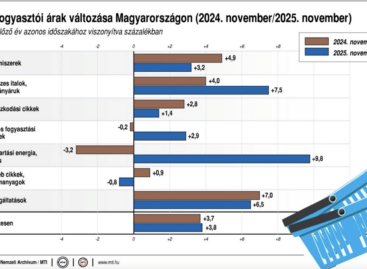The gap between wages and retail sales growth is widening
Last year, 39% of salaries were spent in retail, which is even lower than the Covid year, which showed a very serious decline in retail turnover. While real wages increased by 9.2% in 2024, retail volume increased by only 2.6%, which indicates a kind of rearrangement in the consumption structure. The country is also geographically divided in terms of its retail spending, which is also affected by tourism.
From the beginning of last year, expectations regarding the development of retail turnover were very positive – mainly due to the growth in real wages and the rate of money deterioration approaching the inflation tolerance band from above – but the annual result was sobering compared to expectations. After a promising start to this year, the February retail data already gave reason for caution. Although consumers had already benefited from the effects of the margin stop institution in the second half of March, this was visible in the data filtered from the calendar and base effects, and in the end the volume of turnover could only show a small increase, but what is more problematic is that after February there was a decrease again on a monthly basis. In 2024, a stagnation began just after Easter, which meant a higher consumption level than in 2023, but the 2.6% annual increase was far behind last year’s 9.2% real wage increase.
Retail spending per capita increased in proportion to the national average net wage for two years starting from 2020, which was considered the local minimum interspersed with waves of closures. In 2022, we already left 44.5% of the average salary in retail. Then, the population had to face exceptionally high inflation and – as a result – a decrease in real earnings, so in 2023, the population left 42.1% of their net salary in stores. In 2024, although the rate of inflation slowed down, consumers’ inflationary sentiment did not support this: they continued to encounter high prices on store shelves. For this reason, they did not abandon the savings mechanisms they had adopted. Thus, we see that last year the proportion of the average net salary left in retail decreased to a level even lower than in the covid year, to 39.0%.
Related news
KSH: in November, consumer prices exceeded the values of the same month of the previous year by an average of 3.8 percent
🎧 Hallgasd a cikket: Lejátszás Szünet Folytatás Leállítás Nyelv: Auto…
Read more >Retail sales in a trap of uncertainty
🎧 Hallgasd a cikket: Lejátszás Szünet Folytatás Leállítás Nyelv: Auto…
Read more >KSH: retail turnover in October exceeded the same period of the previous year by 3.1 percent and the previous month by 0.5 percent
🎧 Hallgasd a cikket: Lejátszás Szünet Folytatás Leállítás Nyelv: Auto…
Read more >Related news
Challenges of the retail sector: retail has become more crisis-resistant
🎧 Hallgasd a cikket: Lejátszás Szünet Folytatás Leállítás Nyelv: Auto…
Read more >NGM: conscious shopping for peaceful holidays, consumer protection advice for the Christmas period
🎧 Hallgasd a cikket: Lejátszás Szünet Folytatás Leállítás Nyelv: Auto…
Read more >How to avoid the hassles of online shopping?
🎧 Hallgasd a cikket: Lejátszás Szünet Folytatás Leállítás Nyelv: Auto…
Read more >






